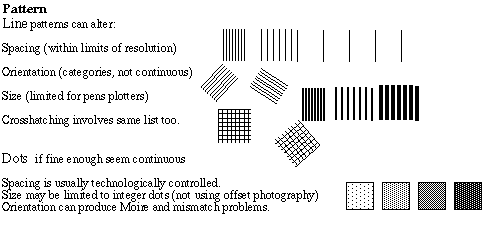Dot based: Line printer (old days), raster CRT (TV) - black/white, color (memory=color)
laser printers (300-600 dots/inch) black & white (grey through raster halftoning),
typesetters (2560 dpi and more)

Photography continuous tone: variations in light make
changes in % silver halide reactions (expensive for multiple copies)
Line systems : pen, scribe tool, engraving (lithography)
black or not, grey through line pattern
Dot systems : Offset printing grey through dots varying
in spacing and size (bigger dots on faster presses)
Line based: use spacing and orientation mostly. Plotter,
vector cathode ray tube (CRT)
laser film recorders (produce litho plates) Some limited ability
to control line width. Now largely obsolete.
Dot based: Line printer (old days), raster CRT (TV) - black/white,
color (memory=color)
laser printers (300-600 dots/inch) black & white (grey through
raster halftoning),
typesetters (2560 dpi and more)

Perception of color: continuous spectrum of photon energy,
but primary, secondary, tertiary relationships do occur
in our perception
Relative perception and illusions
Limited devices: pens with fixed inks, simple CRTs (EGA), ugly
color- TV!
Real color choices: opposite methods of mixing
The "named" colors, organized in a circular fashion with the spectrum "wrapping around" from low energy deep-red purples to high energy purples. The circular nature for the linear spectrum is a perceptual trick from our three receptors (cones).
Dark-to-light axis
Intensity of a hue at the same level of darkness.
Hue works for nominal data, BUT clash and woggle can occur...
Value works for continuous, but there are lots of kinds of continuous...
Figure-Ground issues
Cindy Brewer has written extensively on this subject... including the gorgeous Atlas from Census 2000 (with Trudy Suchan); some additional resources.